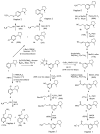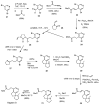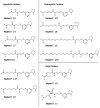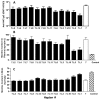Selection of a novel anti-nicotine vaccine: influence of antigen design on antibody function in mice
- PMID: 24098532
- PMCID: PMC3788104
- DOI: 10.1371/journal.pone.0076557
Selection of a novel anti-nicotine vaccine: influence of antigen design on antibody function in mice
Abstract
Anti-nicotine vaccines may aid smoking cessation via the induction of anti-nicotine antibodies (Ab) which reduce nicotine entering the brain, and hence the associated reward. Ab function depends on both the quantity (titer) and the quality (affinity) of the Ab. Anti-nicotine vaccines tested previously in clinical studies had poor efficacy despite high Ab titer, and this may be due to inadequate function if Ab of low affinity were induced. In this study, we designed and synthesized a series of novel nicotine-like haptens which were all linked to diphtheria toxoid (DT) as carrier, but which differed in the site of attachment of linker to nicotine, the nature of linker used, and the handle used to attach the hapten to DT. The resulting hapten conjugates were evaluated in a mouse model, using CpG (a TLR9 agonist) and aluminum hydroxide (Al(OH)3) as adjuvants, whereby Ab titers, affinity and function were evaluated using a radiolabeled nicotine challenge model. A series of additional linkers varying in length, rigidity and polarity were used with a single hapten to generate additional DT-conjugates, which were also tested in mice. Conjugates made with different haptens resulted in various titers of anti-nicotine Ab. Several haptens gave similarly high Ab titers, but among these, Ab affinity and hence function varied considerably. Linker also influenced Ab titer, affinity and function. These results demonstrate that immune responses induced in mice by nicotine-conjugate antigens are greatly influenced by hapten design including site of attachment of linker to nicotine, the nature of linker used, and the handle used to attach the hapten to DT. While both Ab titer and affinity contributed to function, affinity was more sensitive to antigen differences.
Conflict of interest statement
Figures










References
-
- World Health Organization (2011) WHO report on the global tobacco epidemic, 2011: warning about the dangers of tobacco.
-
- Hughes JR, Keely J, Naud S (2004) Shape of the relapse curve and long-term abstinence among untreated smokers. Addiction 99: 29-38. doi:10.1111/j.1360-0443.2004.00540.x. PubMed: 14678060. - DOI - PubMed
-
- Hatsukami DK, Stead LF, Gupta PC (2008) Tobacco addiction. Lancet 371: 2027-2038. doi:10.1016/S0140-6736(08)60871-5. PubMed: 18555914. - DOI - PMC - PubMed
-
- Raupach T, Hoogsteder PH, Onno van Schayck CP (2012) Nicotine vaccines to assist with smoking cessation: current status of research. Drugs 72: e1-16. doi:10.2165/11633630-000000000-00000. PubMed: 22356293. - DOI - PMC - PubMed
MeSH terms
Substances
LinkOut - more resources
Full Text Sources
Other Literature Sources
Medical

